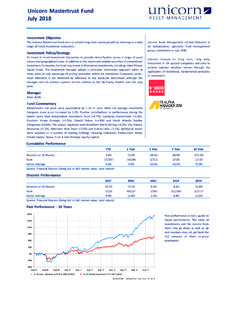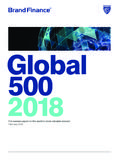Transcription of December 2017 Issue 23 – Special China Edition
1 TermsheetDecember 2017 Issue 23 Special China EditionHeads of TermsChanges in ChinaInvestment in biotech and pharmaceuticals continues to change in China and at PharmaVentures we have seen a more outward looking country, after decades of focus on internal growth and development. China has seen remarkable economic growth in the last two decades, becoming the 2nd largest economy of the world after the US. Despite such growth and a rapid consolidation of Chinese pharmaceutical companies in the past decade, they are still behind their Western counterparts, when it comes to market cap and the level of innovation. This is because they have largely focused on their own internal market and generally not looked far beyond their borders.
2 As a result, no Chinese pharmaceutical company is currently among the world s top 20 pharma/medtech companies list. However, changes are happening rapidly that will likely transform the outlook for Chinese pharmaceutical companies. For example, venture capital is moving away from Health IT to more biotech/medtech companies, led by expert pharma and biotech expats returning to China from the West. Chinese venture capital is also seeking opportunities internationally, in order to access innovation and knowledge outside of China , an example of which is our successful client mandate with Biosceptre which has brought Chinese VC capital to the expect such significant changes to continue in all aspects of Chinese pharmaceutical research and development, including funding, R&D, deal trends, regulations and pricing & reimbursement.
3 For example, in the past pharma companies had to repeat their clinical trials in China , even if the same product was already approved and marketed in other territories. Now they can use clinical trial data from other jurisdictions for Chinese regulatory approval. This will help both domestic and overseas these drivers transforming the Chinese pharmaceutical industry, we find from our own activities that they are now actively pursuing opportunities globally, thus leading to increased cross-border deal volume and subsequent Fintan Walton Chief Executive, PharmaVentures insightdeal updatecontinued on page 2 ..PharmaVentures Client Closes Series A FundingPharmaVentures Capital Limited advises Biosceptre International Limited, a clinical stage oncology company, on its Series A private placement by Tuspark S& the full press release on page Capital Limited is authorised and regulated by the Financial Conduct Authority (741356).
4 PharmaVentures Capital Limited undertakes regulated activities for and on behalf of professional clients only as defined in the FCA handbook COBS Healthcare of Consolidation, Innovation and Capital DeploymentEric Liu Business Analyst, PharmaVentures LimitedDespite the impressive growth observed in China over the last two decades and with a projected healthcare market of RMB 8 trillion (USD trillion), Chinese life science companies lag behind top-tiered Western counterparts, both in terms of market capitalisation and innovation. What makes 2017 remarkable is that the age of pure window shopping by Chinese players seems to be something of the past and companies are actively pursuing international strategies.
5 Ambitious and visionary pharmaceutical companies and healthcare investors are all establishing their footprints across the world. The next five years point to exponential growth in cross-border knowledge and capital exchange, offering unprecedented opportunities for deal making between the West and the East for those who are prepared. This article highlights some of the changes, opportunities and challenges. We believe that three key themes will dominate this coming period: industry consolidation, technological innovation and optimisation of capital operation and deployment. China TodayCurrently, the Chinese healthcare market is experiencing a golden period of growth, with the healthcare market projected to grow to RMB 8 trillion (USD trillion) in 2020 and healthcare costs as a percentage of GDP growing from in 2014 to and 7% by 2020.
6 Over the last 12 months, there have been a number of key initiatives established by the government to boost growth. The latest significant one happened in March 2017 , where the National Health and Family Planning Commission and thirteen other ministries jointly issued the 13th Five-Year Healthy Aging Plan, which strongly encourages private capital deployment and increased healthcare services for the insight.. continued from front pageFrom an R&D perspective, reformation of the China Food and Drug Administration (CFDA) in the last few years has seen a decline in clinical trial registration and generic drug registration, as quality control toughened and companies turned to innovative drug development.
7 In 2016, Category 1, which is the route for innovative drugs, saw 276 clinical trial applications and 127 clinical trial application approvals. Additionally, 4 new drugs were approved by the CFDA in the same year, which compares with that of the US FDA, which approved 22 novel drugs in of regulatory frameworks is a new incentive for growth of the industry. Aligning CFDA to international regulatory standards and supporting bidding policies means there is an increasing number of Chinese enterprises engaging in generic and new drug registration in other jurisdictions, with increasing numbers of clinical trials for innovative medicines. Pharmaceutical manufacturing also continues to show great improvements in quality, with an increasing number of enterprises passing EU and US GMP on-site inspections.
8 Moreover, there has been a significant increase in outbound biotech investment, exceeding a total of USD $5 billion for 2016, despite the money flow controls imposed by the government. Domestic investment preferences have also changed. Healthcare IT investments cooled down drastically in 2016 with significant reductions in valuations. On the other hand, early stage biotech companies led by Western educated Chinese scientists who have returned to the mainland, as well as medical device and precision medicine companies operating in clear niche segments, have been favoured by venture capital investment. Healthcare services and retail chain pharmacies, as the two major terminal users, have also gained increased attention of investors.
9 Fast changing political and regulatory dynamicsThe Chinese healthcare market is heavily influenced by demand in general but also by government policies, which have been fast changing in the last 12 months. In addition to the impact of Centre for Drug Evaluation (equivalent to US Center for Drug Evaluation and Research) increasing its staff size five-fold to help with regulatory backlogs, there have been four major changes impacting the industry:1 The central government in August 2016 held the first national health conference since the turn of 21st century. Since then, the Healthy China 2030 plan, the 13th Five-Year Health and Wellness Planning and the 13th Five-Year Deepening Medical and Health System Reform Plan have all been Changes and improvements in quality control and regulatory supervision.
10 3 Significant healthcare reforms, including structural reforms of national medical insurance, healthcare institutions and medicine supply to improve access to care and medicines for the public. 4 Multiple policies supporting the growth of the life science industry, including from the State Council, Development and Reform Commission, Ministry of Industry and others in areas such as taxation, R&D support and Healthcare and ChallengesIn our opinion the Chinese market presents five areas of opportunity:1 A steady increase in the demand for healthcare driven by the aging population and increased healthcare product consumption. 2 Technological advancements such as breakthrough therapies and smart medical devices are opening new market Supportive policies for manufacturing, research and Significant regulatory changes as described above.




